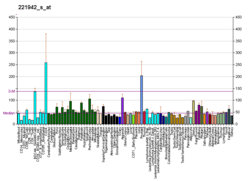GUCY1A3
Guanylate cyclase soluble subunit alpha-3 is an enzyme that in humans is encoded by the GUCY1A3 gene.[5][6]
Function
Soluble guanylate cyclase (sGC), a heterodimeric protein consisting of an alpha and a beta subunit, catalyzes the conversion of GTP to the second messenger cGMP and functions as the main receptor for nitric oxide and nitrovasodilator drugs.[6] Mutations in this gene have been associated to cases of myocardial infarction (10.1038/nature12722).
References
- 1 2 3 GRCh38: Ensembl release 89: ENSG00000164116 - Ensembl, May 2017
- 1 2 3 GRCm38: Ensembl release 89: ENSMUSG00000033910 - Ensembl, May 2017
- ↑ "Human PubMed Reference:".
- ↑ "Mouse PubMed Reference:".
- ↑ Giuili G, Scholl U, Bulle F, Guellaen G (Jul 1992). "Molecular cloning of the cDNAs coding for the two subunits of soluble guanylyl cyclase from human brain". FEBS Lett. 304 (1): 83–8. doi:10.1016/0014-5793(92)80594-7. PMID 1352257.
- 1 2 "Entrez Gene: GUCY1A3 guanylate cyclase 1, soluble, alpha 3".
Further reading
- Giuili G, Roechel N, Scholl U, et al. (1993). "Colocalization of the genes coding for the alpha 3 and beta 3 subunits of soluble guanylyl cyclase to human chromosome 4 at q31.3-q33". Hum. Genet. 91 (3): 257–60. doi:10.1007/BF00218267. PMID 8097486.
- Papapetropoulos A, Cziraki A, Rubin JW, et al. (1996). "cGMP accumulation and gene expression of soluble guanylate cyclase in human vascular tissue". J. Cell. Physiol. 167 (2): 213–21. doi:10.1002/(SICI)1097-4652(199605)167:2<213::AID-JCP4>3.0.CO;2-S. PMID 8613461.
- Zabel U, Weeger M, La M, Schmidt HH (1998). "Human soluble guanylate cyclase: functional expression and revised isoenzyme family". Biochem. J. 335 (1): 51–7. PMC 1219751. PMID 9742212.
- Zhou Y, Zheng JB, Gu X, et al. (2000). "A novel Pax-6 binding site in rodent B1 repetitive elements: coevolution between developmental regulation and repeated elements?". Gene. 245 (2): 319–28. doi:10.1016/S0378-1119(00)00019-6. PMID 10717483.
- Behrends S, Vehse K, Scholz H, et al. (2000). "Assignment of GUCY1A3, a candidate gene for hypertension, to human chromosome bands 4q31.1→q31.2 by in situ hybridization". Cytogenet. Cell Genet. 88 (3–4): 204–5. doi:10.1159/000015548. PMID 10828587.
- Strausberg RL, Feingold EA, Grouse LH, et al. (2003). "Generation and initial analysis of more than 15,000 full-length human and mouse cDNA sequences". Proc. Natl. Acad. Sci. U.S.A. 99 (26): 16899–903. doi:10.1073/pnas.242603899. PMC 139241. PMID 12477932.
- Ota T, Suzuki Y, Nishikawa T, et al. (2004). "Complete sequencing and characterization of 21,243 full-length human cDNAs". Nat. Genet. 36 (1): 40–5. doi:10.1038/ng1285. PMID 14702039.
- Saino M, Maruyama T, Sekiya T, et al. (2005). "Inhibition of angiogenesis in human glioma cell lines by antisense RNA from the soluble guanylate cyclase genes, GUCY1A3 and GUCY1B3". Oncol. Rep. 12 (1): 47–52. doi:10.3892/or.12.1.47. PMID 15201957.
- Meurer S, Pioch S, Wagner K, et al. (2005). "AGAP1, a novel binding partner of nitric oxide-sensitive guanylyl cyclase". J. Biol. Chem. 279 (47): 49346–54. doi:10.1074/jbc.M410565200. PMID 15381706.
- Gerhard DS, Wagner L, Feingold EA, et al. (2004). "The status, quality, and expansion of the NIH full-length cDNA project: the Mammalian Gene Collection (MGC)". Genome Res. 14 (10B): 2121–7. doi:10.1101/gr.2596504. PMC 528928. PMID 15489334.
This article is issued from
Wikipedia.
The text is licensed under Creative Commons - Attribution - Sharealike.
Additional terms may apply for the media files.




